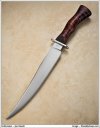Bruceter
Gold Member
- Joined
- May 19, 2000
- Messages
- 1,476
Greetings all,
I have some maple scales that I am putting on a blade blank I was given. Wiping the scales with alcohol or water shows a nice bit of tiger-stripe to it.
Will some light stain help bring out the striping? Or, is something like tru-oil enough?
TIA
Bruceter
I have some maple scales that I am putting on a blade blank I was given. Wiping the scales with alcohol or water shows a nice bit of tiger-stripe to it.
Will some light stain help bring out the striping? Or, is something like tru-oil enough?
TIA
Bruceter




